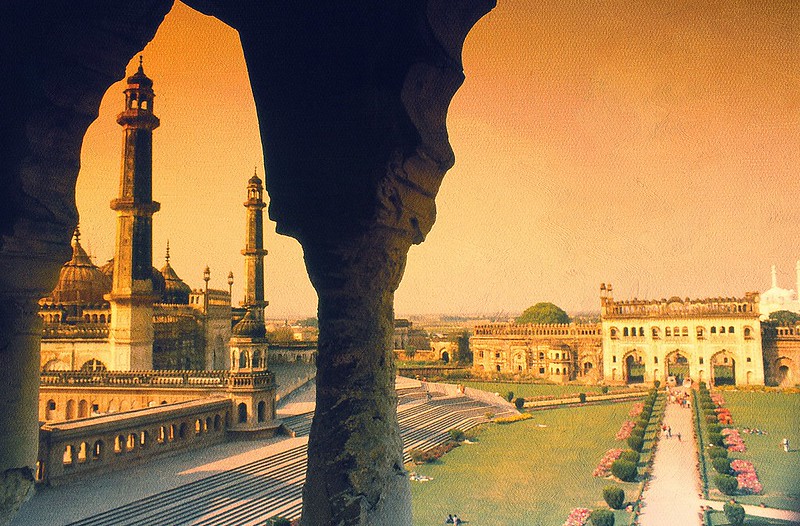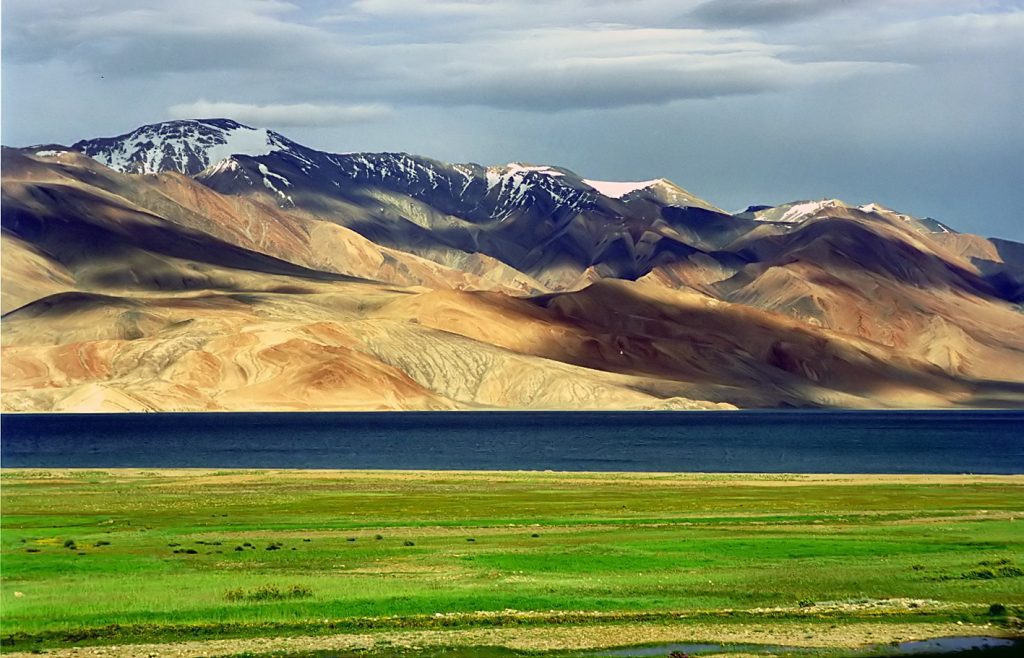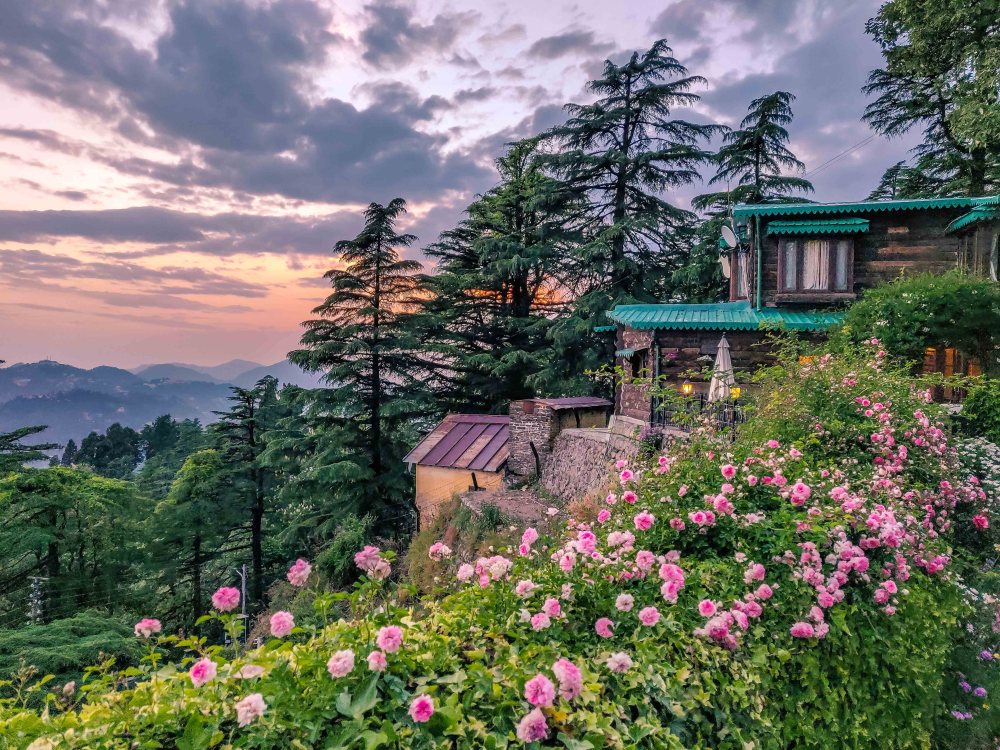For individuals deeply connected with their spiritual beliefs, the journey to hallowed grounds holds great significance. In the realm of such sacred pilgrimages, the 64 Jyotirlingas of India, emblematic of Lord Shiva, emerge as a profound spiritual quest. While the aspiration to visit all 64 sites may be ambitious for many, a more realistic spiritual journey involves the 12 Jyotirlingas of India. These sanctified sites are believed to be powerful conduits for the purification of sins and the attainment of deep spiritual enlightenment, especially when visited at least once in a lifetime.
The term ‘Jyotirlinga’ combines ‘jyothi’, signifying light, and ‘linga’, representing Shiva. These 12 luminous embodiments of Lord Shiva are revered in Hinduism for their profound spiritual significance. Each of the 12 Jyotirlinga temples is named after the specific form of Shiva it honours, with each one symbolizing a distinct aspect of the deity. Central to these temples is the ‘lingam’, a symbolic representation of the cosmic pillar, signifying both the creation and the boundless nature of Lord Shiva.
Setting out on a road journey to these 12 divine locations across India is not just a travel experience, but a path to spiritual awakening. However, one must remember that these temples are dispersed across eight different states, demanding substantial time for a complete pilgrimage. For those embarking on this sacred voyage, it’s advisable to travel in a vehicle that is both robust and reliable to navigate the diverse terrains. Booking a Savaari in Ahmedabad offers a promising start for your Jyotirlingas journey marked by comfort and peace. Here’s an intriguing guide to the 12 Jyotirlingas of India, also referred to as Dwadasa Jyotirlingas, which stand as the most sanctified shrines in Hinduism.
Table of contents
- Exploring the spiritual and cultural significance of the 12 Jyotirlingas
- The connection between the 12 Jyotirlingas and zodiac signs
- Legends and lore ‐ The comprehensive guide to India’s 12 Jyotirlingas
- Somnath – Gir Somnath, Gujarat – The first holy shrine
- The Kailash of the South ‐ The majestic Mallikarjuna Jyotirlinga
- Divine aura and ancient lore ‐ The Mahakaleshwar Jyotirlinga
- Sacred isle of Om ‐ The Omkareshwar and Mamleshwar Temples in Madhya Pradesh
- Sanctum of healing ‐ The revered Baidyanath Jyotirlinga in Jharkhand
- Sacred wilderness‐ Bhimashankar Jyotirlinga amidst Maharashtra’s natural beauty
- Divine odyssey ‐ The spiritual glory of Rameshwaram Jyotirlinga
- Guardian of devotion ‐ The mystical Nageshwar Jyotirlinga
- Eternal flame of divinity ‐ The Kashi Vishwanath Temple in Varanasi
- The divine splendor of Trimbakeshwar Jyotirlinga in Nashik
- Sacred summit ‐Kedarnath Jyotirlinga in Uttarakhand
- Divine sanctuary of faith ‐ Ghrishneshwar Jyotirlinga in Aurangabad
- How to plan the Jyotirlinga road trip ‐ A step-by-step location guide
- Essential tips for a successful Jyotirlinga road trip
- Why go on a Jyotirlinga road trip with Savaari?
Divine light of Shiva ‐ Exploring the spiritual significance of the 12 Jyotirlingas
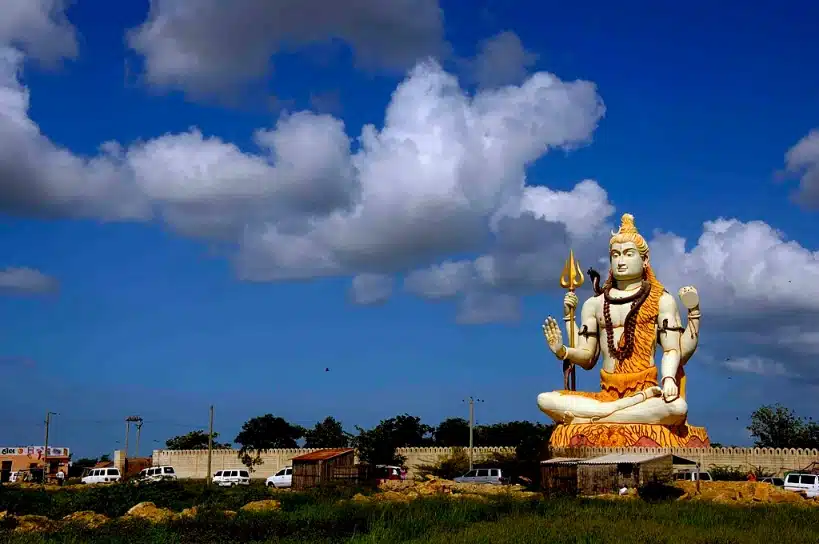
The 12 Jyotirlingas of India hold immense significance in Hinduism, stemming from a mythological tale in the Shiva Purana. According to the legend, a dispute arose between Lord Brahma and Lord Vishnu over who was superior. In response, Lord Shiva appeared as an immense, infinite pillar of light, the Jyotirlinga, challenging Brahma and Vishnu to find its end.
In their quest to prove their supremacy, Brahma claimed to have reached the top, presenting a ketakī flower as evidence, while Vishnu conceded his inability to find the end. Shiva, angered by Brahma’s dishonesty, cursed him to not be worshipped on Earth, while Vishnu was blessed for his honesty. The Jyotirlinga shrines symbolize the places where Shiva manifested as this column of light, representing his infinite nature. For many, visiting these shrines is a journey towards inner peace and understanding the profound facets of Hinduism. The journey across India to these 12 sites is as enriching in cultural experiences as it is in spiritual awakening.
The connection between the 12 Jyotirlingas of India and zodiac signs
The 12 Jyotirlingas of India, revered embodiments of Lord Shiva, hold immense spiritual power and are situated at locations of astronomical significance. Each Jyotirlinga is closely associated with a specific planet (Navagraha), offering unique benefits linked to that celestial body. Moreover, these sacred sites each resonate with the energies of the 12 astrological signs. Ancient Vedic scriptures reveal the deep connection between these 12 Jyotirlingas of India and the energies of different zodiac signs. Thus, they are intricately linked with the lunar signs (Rashis) in Vedic astrology. The placement and the very essence of each Jyotirlinga are crafted to harness the natural forces, making their impact profoundly potent.
Aries aligns with Rameshwaram, enhancing marital harmony; Taurus with Somnath, embodying stability; Gemini with Nageshwar, offering protection; Cancer with Omkareshwar, symbolizing wisdom; Leo with Vaidyanath, focusing on vitality; Virgo with Mallikarjun, enhancing intellect; Libra with Mahakaleshwar, offering protection; Scorpio with Grishneshwar, aiding in overcoming challenges; Sagittarius with Kashi Vishwanath, guiding towards enlightenment; Capricorn with Bhimashankar, for those with challenging Mars placements; Aquarius with Kedarnath, symbolizing spiritual growth; and Pisces with Trimbakeshwar, bringing comfort and spiritual rebirth. Each Jyotirlinga’s unique association with a zodiac sign underscores the deep astrological and spiritual connections in Hinduism. To delve deeper into the significance of astrology in Hindu tradition, explore the myriad of stories featured in our travel magazine, available for free download.
Legends and lore ‐ The comprehensive guide to India’s 12 Jyotirlingas
Jyotirlingas represent more than mere centers of worship; they are focal points of celestial power, marking the locations where Shiva appeared as a luminous beam. These sacred sites draw Hindu devotees seeking deeper spiritual understanding and enlightenment. Embarking on a pilgrimage to these 12 Jyotirlingas of India transcends traditional religious rituals, unfolding as an exploration of both cultural heritage and spiritual growth. Each Jyotirlinga is enveloped in its own unique mythology and embodies different facets of Shiva, offering a window into the deity’s multifaceted nature. Travelling to these 12 locations across India provides a journey that is as culturally enriching as it is spiritually enlightening.
1. Somnath – Gir Somnath, Gujarat – The first holy shrine
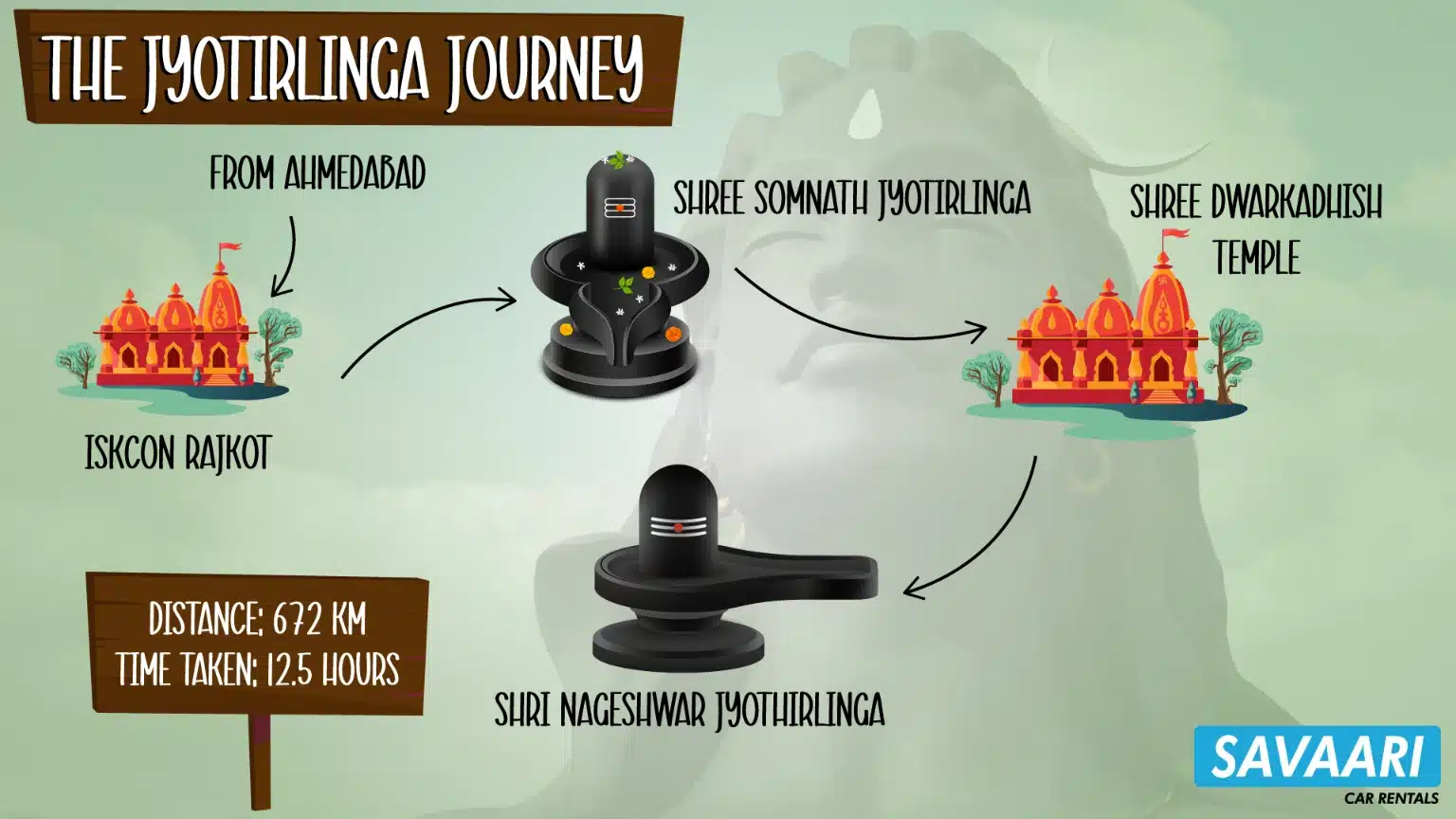
The Somnath Jyotirlinga in Gujarat stands as one of the 12 Jyotirlingas of India dedicated to Lord Shiva in India. This is considered as the first Jyotirlinga of Earth. This temple, steeped in religious importance, has been a sacred pilgrimage destination for many generations and is celebrated for its stunning architecture. It serves as a symbol of the enduring faith and devotion of its worshippers, having been reconstructed numerous times following destructions. Set against the vast expanse of the Arabian Sea, the temple’s peaceful setting offers a spiritually uplifting experience for both pilgrims and visitors. Historically, the temple is believed to have been constructed in opulent gold and silver but suffered significant damage by invaders and rulers such as Aurangzeb.
The Moon God’s tale behind Somnath’s creation
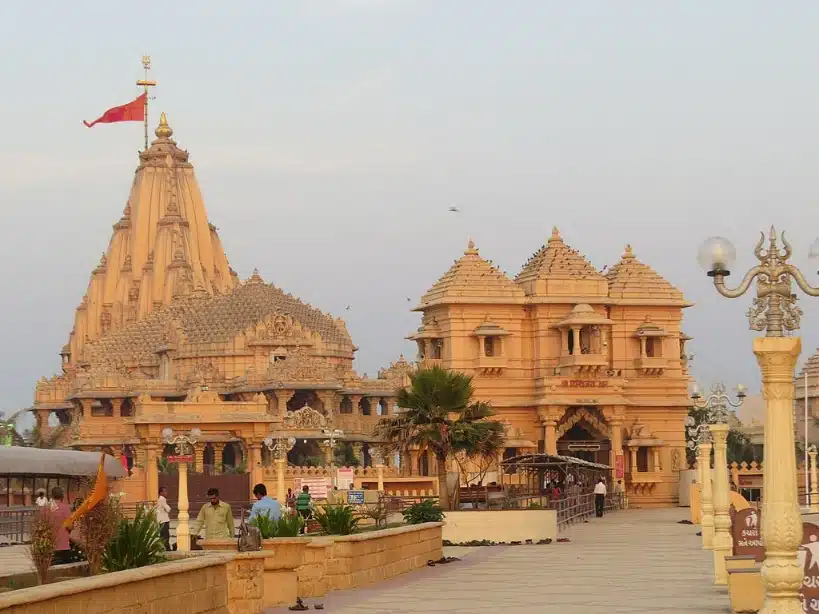
The story behind Somnath Temple involves the Moon God, ‘Somdev’, who favoured his wife Rohini over his other 26 wives, all daughters of Daksha Prajapati. Angered by this, Daksha Prajapati cursed Somdev, causing him to lose his luminosity. Distraught, Somdev devotedly worshipped the Jyotirlinga of Lord Shiva for 4000 years at the site of the current temple.
Impressed by his devotion, Lord Shiva granted a reprieve, allowing the Moon to diminish in brightness for only half of each month. In gratitude, the Moon God established this temple to honor Lord Shiva. It is also believed that Lord Brahma advised the Moon God to construct this shrine. Historical records suggest the temple dates back to between 320 and 500 AD.
Distance from Ahmedabad to Somnath – 408.9 km
Temple Timings – Open daily from 6:00 AM to 10:00 PM.
Aarti timings – 7 AM, 12 noon, and 7 PM.
Special attraction – ‘Joy Somnath’ light and sound show, every evening between 8 to 9.
Best time to visit – The best time for visiting the Somnath Jyotirlinga are between October to February. The climate in this season stays cool and is substantially recommended for sight- seeing. The temperature remains between 10 to 32- degree centigrades. The temperature remains fluctuating between 10 and 32 degrees Celsius.
2. The Kailash of the South ‐ The majestic Mallikarjuna Jyotirlinga
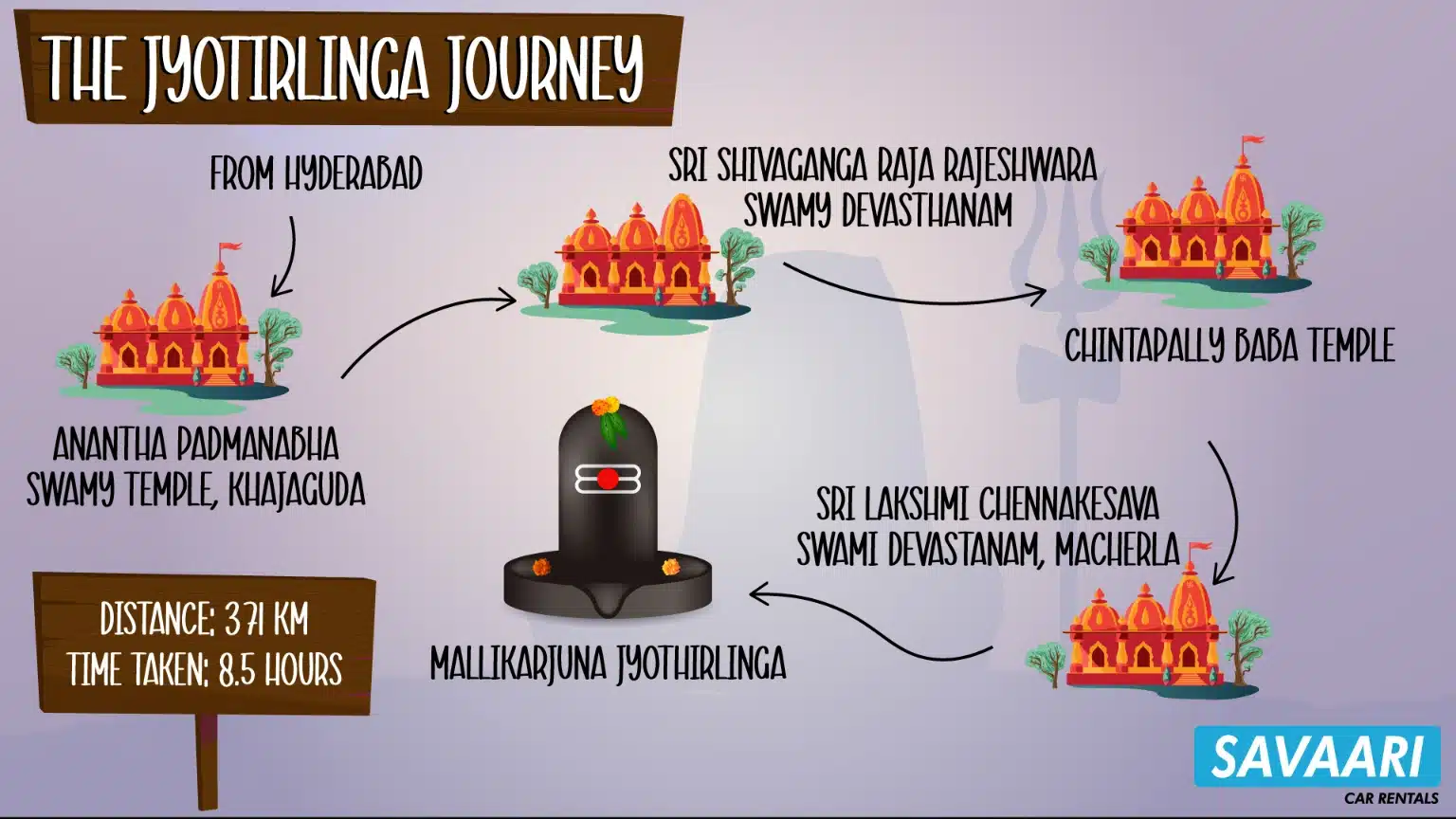
Mallikarjuna Jyotirlinga, also recognized as the Srisailam Temple, resides amidst the scenic beauty of the Nallamala Hills in Andhra Pradesh. This temple, one of the 12 Jyotirlingas of India dedicated to Lord Shiva, shares its holy grounds with the temple of Goddess Bhramaramba, enhancing its spiritual significance. Mallikarjuna, rich in historical and religious importance, is not only a center of devotion for Shiva followers but also a testament to the splendor of ancient Indian temple architecture. Its location, surrounded by lush forests and the meandering Krishna River, provides a tranquil haven for devotees and visitors alike. To ensure a comfortable and stress-free trip to Mallikarjuna Jyotirlinga, you can conveniently book a taxi from Hyderabad.

Divine reconciliation ‐ The mythical story behind Mallikarjuna’s origin
As narrated in the Shiv Purana, this sacred site on Krauncha Mountain became the abode of a Jyotirlinga when Lord Shiva, along with Goddess Parvati, manifested here to appease their son Kartikeya. Kartikeya’s discontent stemmed from the marriage of his younger brother, Lord Ganesh, before him. The temple houses the deities of Mallikarjuna (Lord Shiva) and Bhramarambha (Goddess Parvati). Uniquely, it is the only temple where devotees are granted the rare privilege of touching the idols, a practice not permitted in other Shiva temples.
Distance from Hyderabad to Mallikarjun – 229.5 km
Temple Timings – Open daily from 4:30 AM to 10:00 PM.
Special attraction – Jathra Mahotsavam held during the month of March is the most popular attraction of Mallikarjuna Temple.
3. Divine aura and ancient lore ‐ The Mahakaleshwar Jyotirlinga
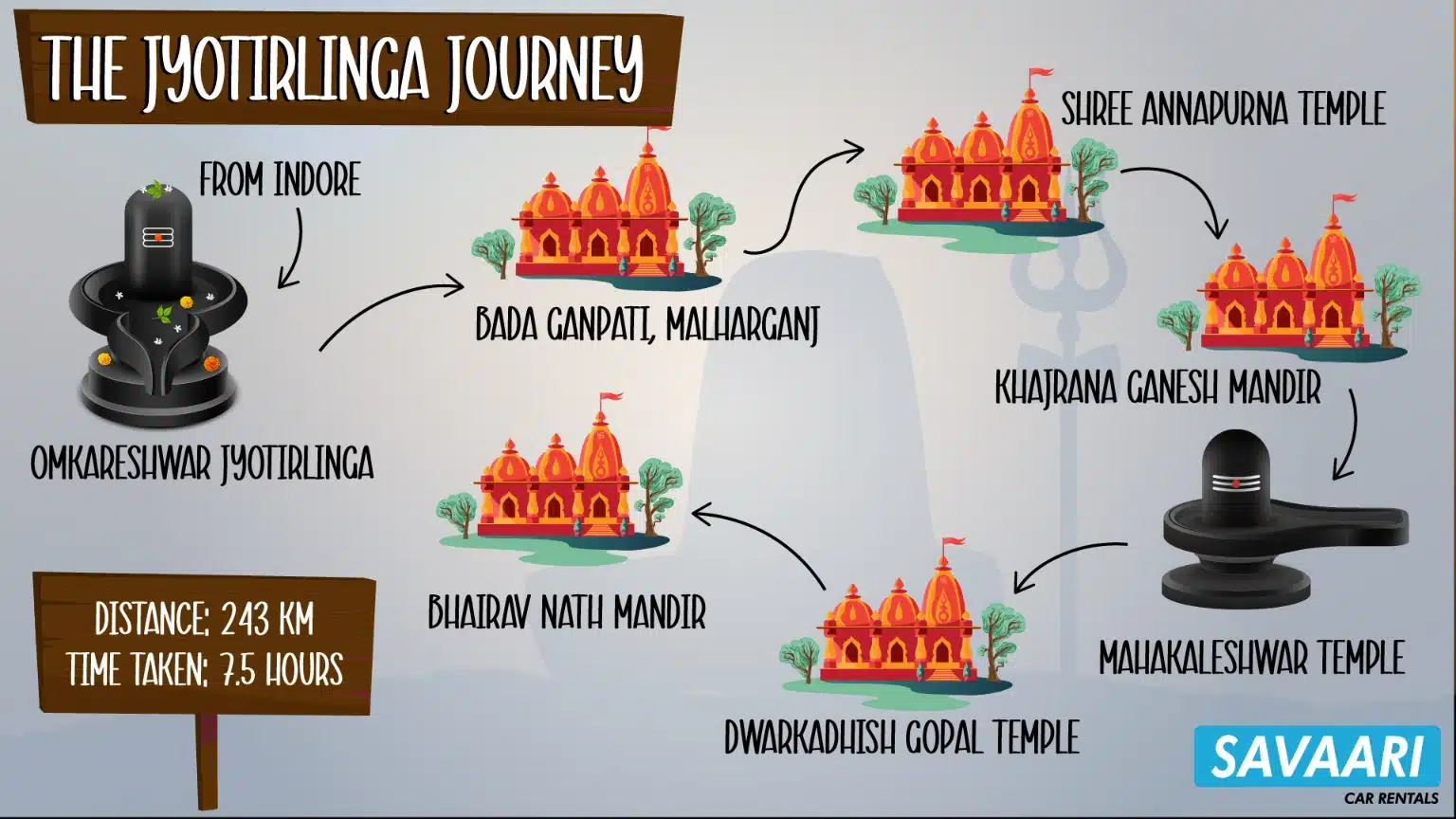
Nestled in the historic city of Ujjain, Madhya Pradesh, Mahakaleshwar Jyotirlinga is celebrated as one of the most sacred among the 12 Jyotirlingas of India devoted to Lord Shiva. Situated on the picturesque banks of Rudra Sagar Lake, the temple is famed for its exquisite architectural beauty and the distinctive Bhasma Aarti, a ritual involving the anointing of the deity with holy ash. This temple is not only a spiritual hub but also a beacon for historians and tourists, thanks to its rich historical context and serene ambience. Mahakaleshwar, extolled in ancient texts and hymns, embodies the profound spiritual heritage and traditions of India. The ‘Bhasm-Aarti’ is a highlight of the temple, performed as the first rite of the day, where the Shivlinga is bathed in ashes from a fresh funeral pyre. This ritual draws thousands of devotees worldwide, particularly during the month of Sawan and Nag Panchami.
Victory of the divine ‐ The myth of Mahakaleshwar’s emergence in Ujjain
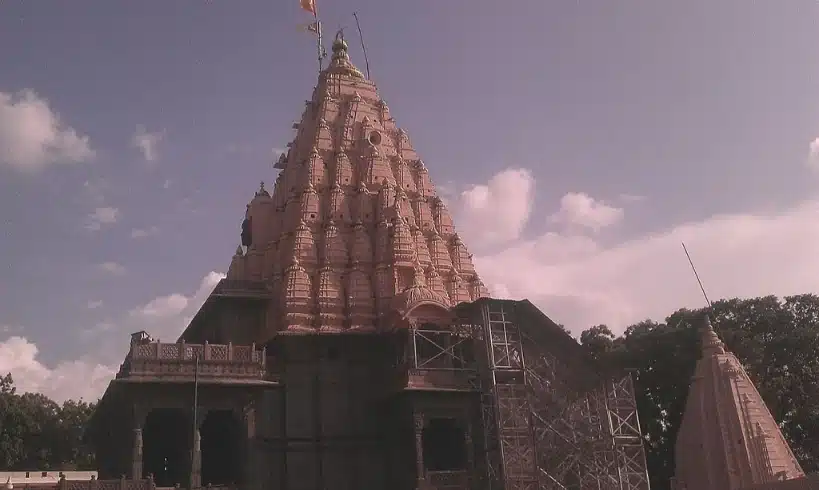
Among various mythological tales associated with Mahakaleshwar Temple, the most prevalent narrates Lord Shiva’s emergence from the earth in Ujjain to defeat the demon Dushana. Dushana’s atrocities on the residents and Brahmins of Ujjain had become unbearable. After slaying the demon, Lord Shiva manifested as a Jyotirlinga, choosing to reside in this sacred city and bestow his divine blessings ever since. Book a chauffeured cab from Bhopal to Mahakaleshwar for a hassle-free journey.
Distance from Bhopal to Mahakaleshwar: 196.1 km
Temple Timings: Open daily from 3:00 AM to 11:00 PM.
Special attraction: The ‘Bhasm-Aarti’ is a highlight of the temple, performed as the first rite of the day.
Best time to visit: This season spans the months of October through March. The temperature stays at 20 degrees. The rainfall remains affable and is good for the pilgrims. Since summertime temperatures can reach up to 45 degrees centigrade, it is advised to avoid them.
4. Sacred isle of Om ‐ The Omkareshwar and Mamleshwar Temples in Madhya Pradesh
In the tranquil setting of Mandhata Island on the Narmada River in Madhya Pradesh, the fourth sacred Jyotirlinga of Lord Shiva graces the Omkareshwar and Mamleshwar temples. This island, believed to be shaped like the sacred ‘Om’ symbol from Hindu mythology, becomes a hub of spirituality during Shivratri, Mahashivratri, and Kartik Poornima, as thousands of devotees flock for darshans. The serene ambiance and the scenic beauty of the Narmada River enhance the sanctity of these shrines. The Mamleshwar temple stands apart from Omkareshwar, separated by a slender ridge.
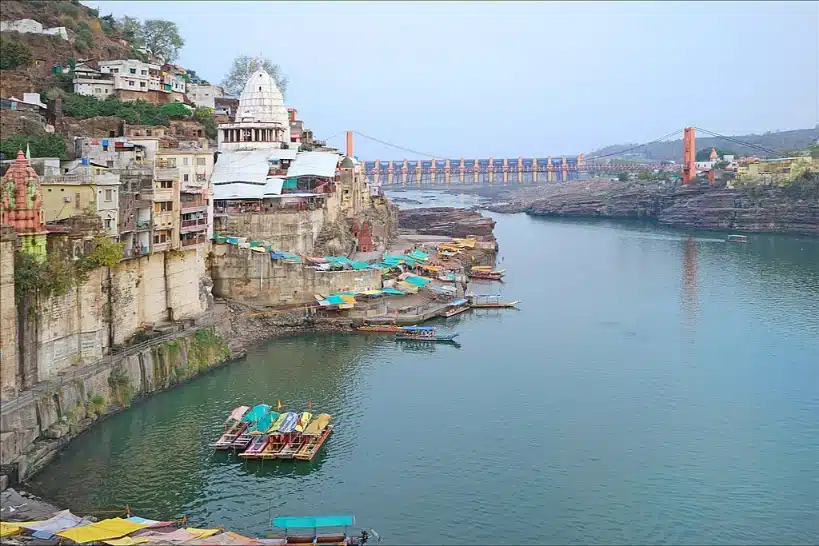
Mythical origins ‐ The trio of tales behind Omkareshwar Jyotirlinga
There are three significant legends associated with the Omkareshwar Jyotirlinga in Hindu mythology. The first legend tells of ‘Vindhya Parbat’ performing penance to appease Lord Shiva. Pleased, Shiva appeared and granted Vindhya’s wish to be greater than ‘Meru Parbat’. The Linga worshipped by Vindhya Parbat eventually divided into two parts, ‘Omkareshwar’ and ‘Mamleshwar’, at the request of gods and sages, symbolizing the unity of the Shiva Lingam.
The second story revolves around King Mandhata and his sons, whose devout penance led to Lord Shiva’s appearance as a Jyotirlinga. The third narrative describes Lord Shiva, in the form of Omkareshwar, triumphing over the Asuras in a fierce battle between the Devas and Asuras.
Distance from Indore to Omkareshwar: 78.2 km
Temple Timings: Open daily from 5:00 AM to 10:00 PM.
Special Attraction: During Maha Shivratri, a grand fair is organized, and the temple trust provides feast (bhandara) for the devotees.
Best time to visit: During October to March, the climate remains affable that helps excursionists to see the sights with ease. The temperature is constant at 15 to 30 degrees Celsius. It’s recommended to avoid summers as it gets hot and uncomfortable.
5. Sanctum of healing ‐ The revered Baidyanath Jyotirlinga in Jharkhand
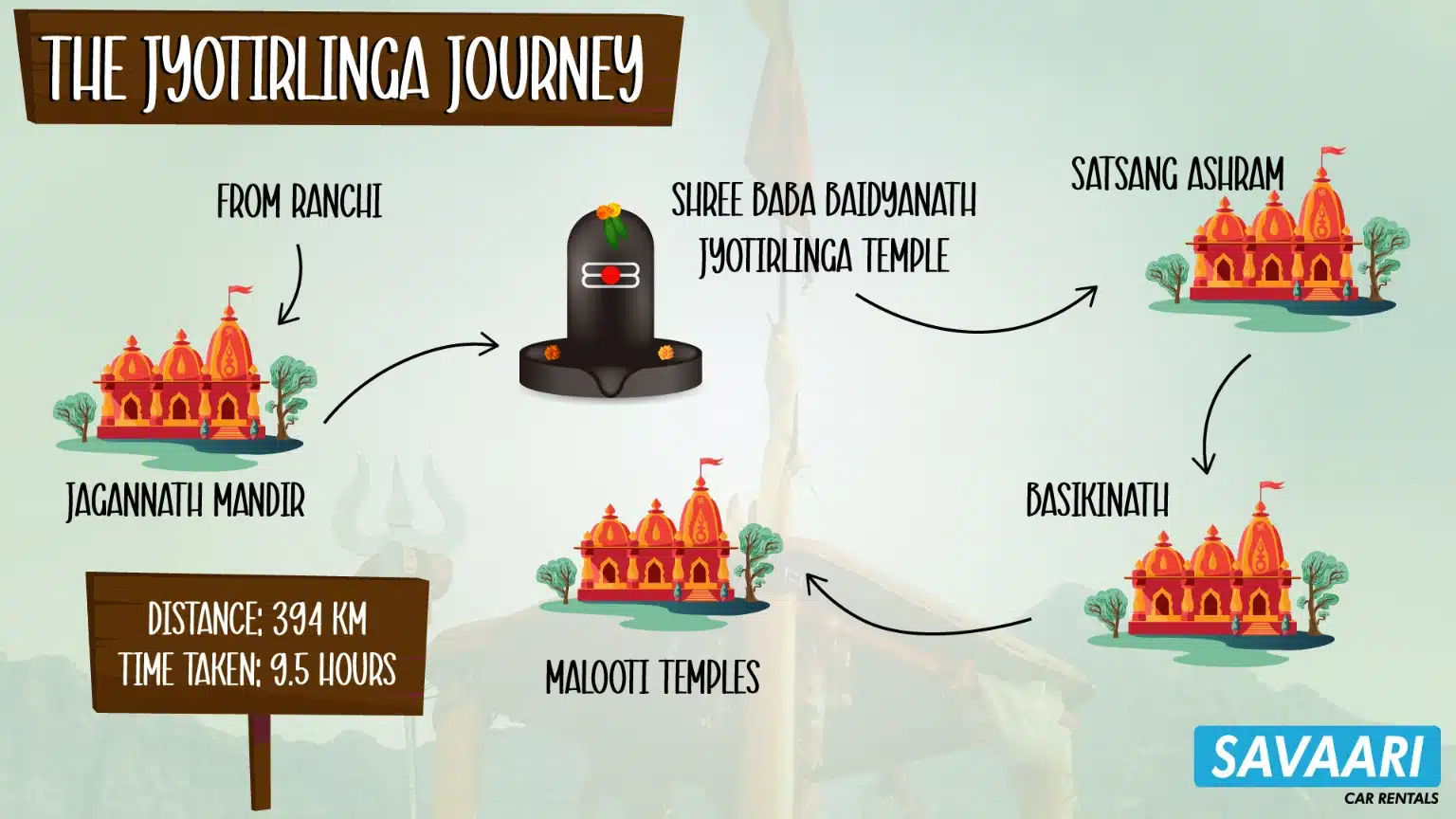
Located in Deoghar, Jharkhand, Baidyanath Jyotirlinga stands as one of the most esteemed among the 12 Jyotirlingas of India dedicated to Lord Shiva. This temple is not just a pivotal religious site but also a testament to the grandeur of ancient Indian architecture, with its walls featuring elaborate carvings. Annually, during the Shravan month, millions of devotees partake in the ‘Shravani Mela’, a rigorous pilgrimage to offer holy water to the deity, showcasing their deep devotion. The temple’s hallowed presence, coupled with Deoghar’s tranquil environment, provides a haven for spiritual rejuvenation for both devotees and visitors.
Ravana’s devotion ‐ The mythological roots of Baidyanath Dham
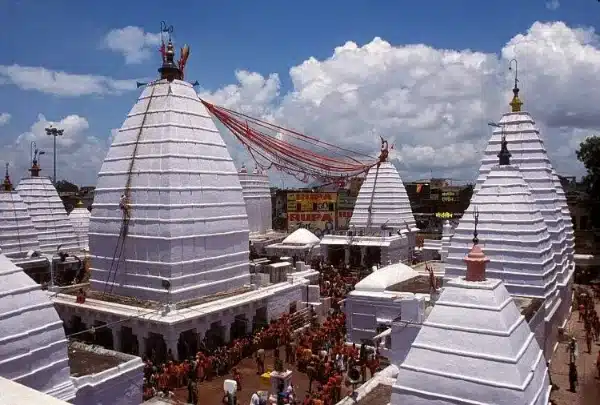
A renowned legend associated with this site narrates that Ravana, the demon king, beheaded himself to win Lord Shiva’s favor. Shiva, acting as a healer (Vaidya), reattached Ravana’s heads, leading to the naming of the place as Baidynath Dham. It is widely believed that praying at this temple bestows health and prosperity upon the devotees. The temple hosts a bustling annual fair during the monsoon months of July and August, attracting throngs of worshippers. It also makes for a scenic drive, so book a car rental from Ranchi to reach the Baidhyanath Dham comfortably.
Distance from Ranchi to Baidyanath: 254.8 km
Temple Timings: Baidyanath temple opens daily at 4:00 AM with the “Mangal Aarti” and concludes its day with the “Shringar Aarti” at around 9:00 PM.
Best Time to visit: During October to March, the climate remains affable which helps excursionists to see the sights with ease. The temperature is constant between 15 to 30 degrees Celsius. Summers are best avoided because they can be quite hot and uncomfortable.
6. Sacred wilderness‐ Bhimashankar Jyotirlinga amidst Maharashtra’s natural beauty
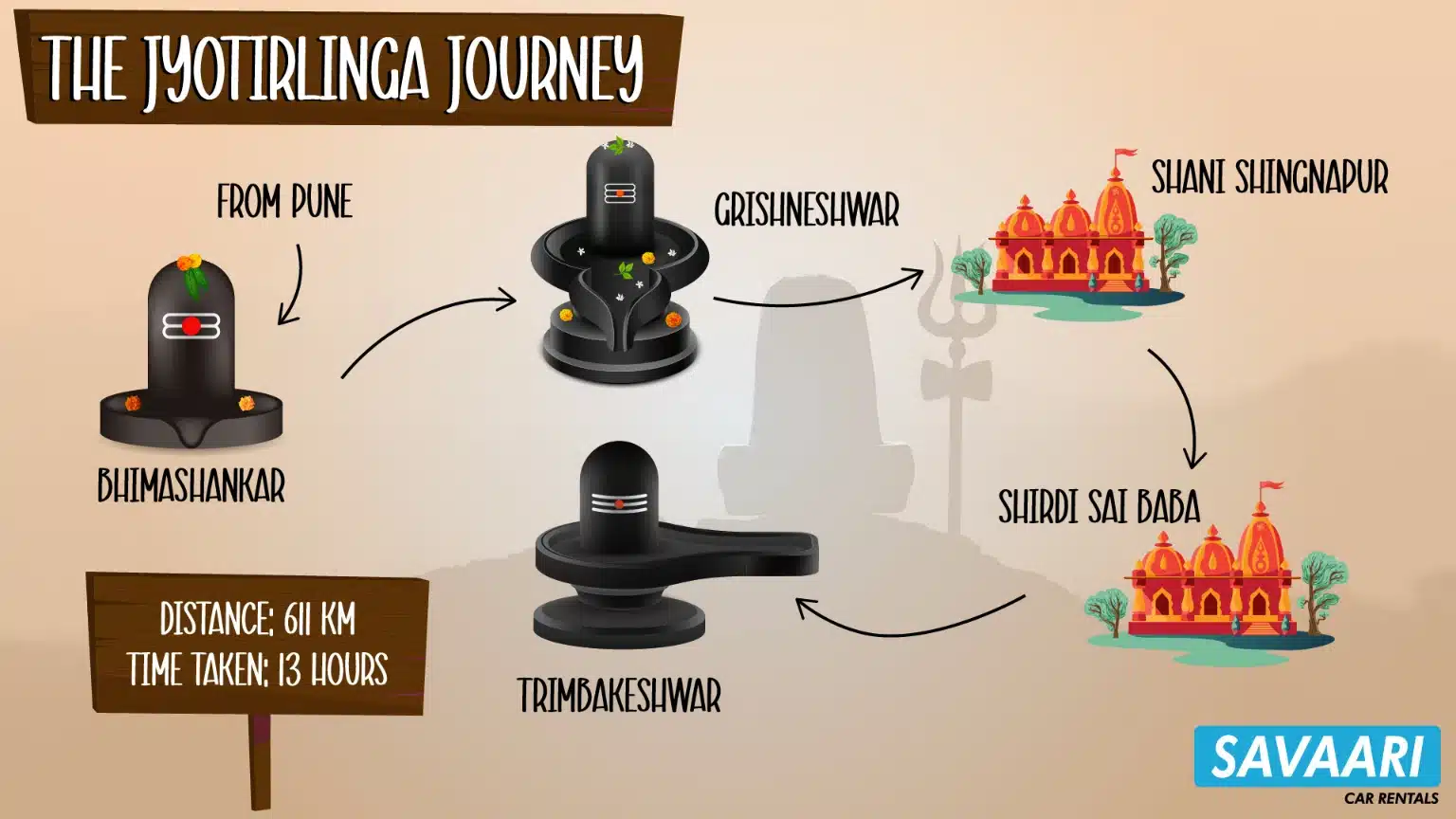
Bhimashankar Jyotirlinga, cradled in the verdant Western Ghats of Maharashtra, epitomizes the harmonious blend of spiritual sanctity and natural beauty. This temple, revered as one of the 12 Jyotirlingas of India, is not just a site of immense religious importance but also an architectural wonder, showcasing exquisite Nagara-style craftsmanship. Surrounding Bhimashankar, a recognized wildlife sanctuary, the area is a paradise for nature lovers. The temple’s tranquil atmosphere, combined with the natural symphony of bird calls, offers a peaceful and divine experience to visitors.
Divine battle and creation ‐ The myth of Lord Shiva at Bhimashankar
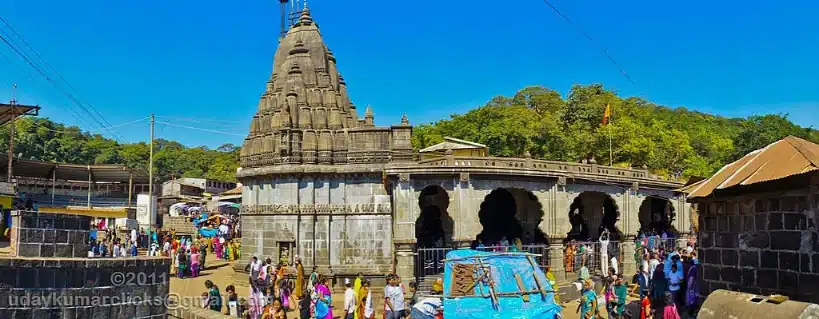
In Hindu Puranic lore, Lord Shiva adopted a fierce ‘rudra’ form to vanquish the malevolent demon Tripurasura, who threatened the three realms: Heaven, Hell, and the Netherworld (Patal). Post his victory, Shiva rested on the Sahyadri Mountains, where his perspiration formed the Bhima River. Heeding the Devas’ request, Shiva resided on these mountains as a Jyotirlinga, marking the site with his divine presence. Book a Savaari from Pune to travel to Bhimashankar in comfort.
Distance from Pune to Bhimashankar: 123.3 km
Temple Timings: The temple is open daily from 5:00 AM to 9:00 PM.
Highlights: The Bhimashankar area is dotted with other sacred sites like ‘Gupt Bhimashankar’, ‘Hanuman Lake’, ‘Mokshakund Teertha’, and ‘Kamalja Mata Temple’, enhancing its religious significance.
Best time to visit: Although the temple could be visited at any time, it’s best to pay a visit from October to February as it covers the downtime season. The temperature remains constant at 13 to 30 degrees Celsius.
7. Divine odyssey ‐ The spiritual glory of Rameshwaram Jyotirlinga
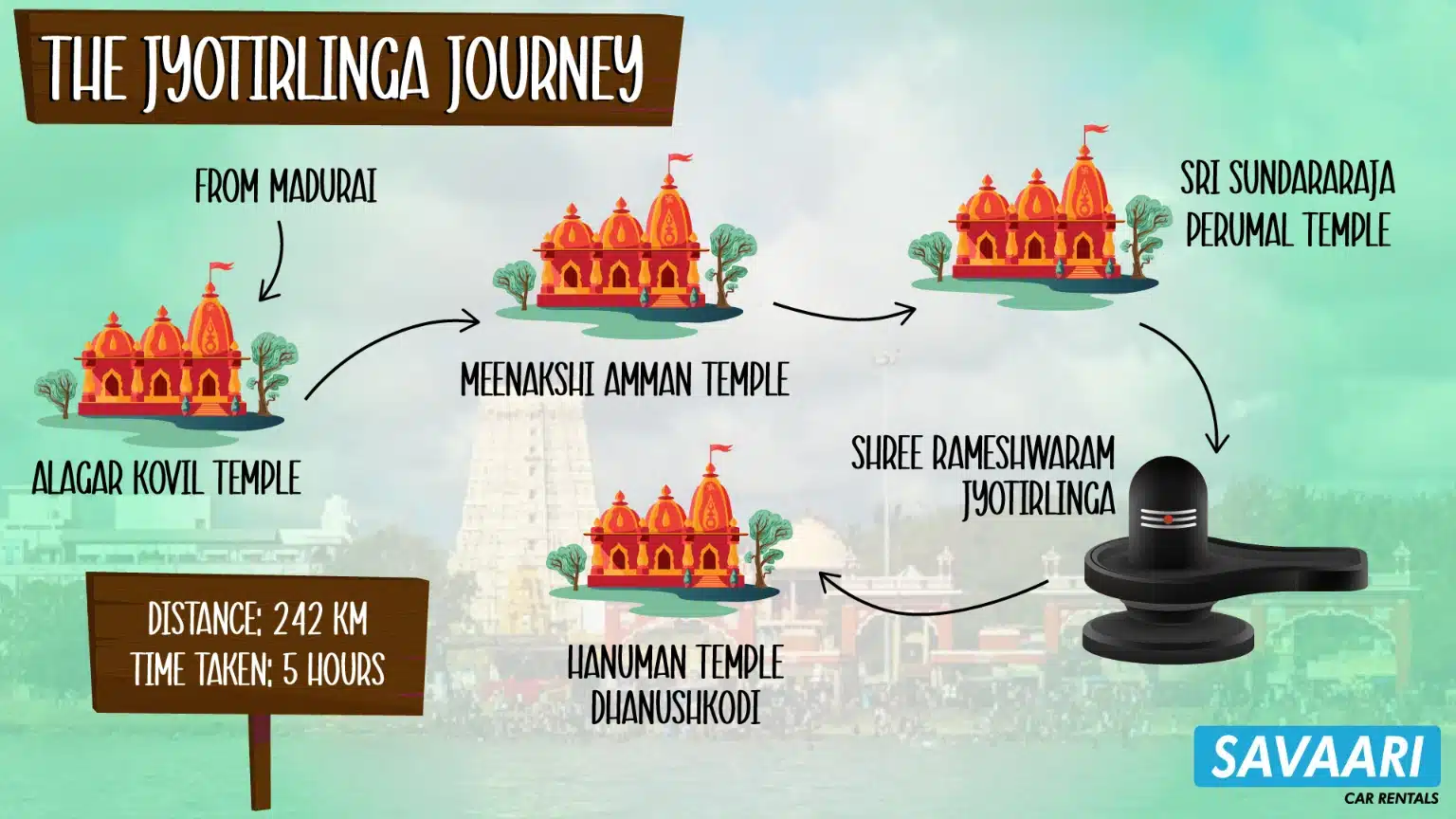
Located on the sacred island of Rameswaram in Tamil Nadu, Rameshwar Jyotirlinga, also known as Ramanathaswamy Temple, is one of the 12 Jyotirlingas of India and a key pilgrimage site in the Char Dham circuit for Hindus. This temple is not only an architectural marvel, featuring the longest pillared corridor among Hindu temples, but also a spiritual nexus deeply intertwined with the epic Ramayana. It serves as a fusion of faith, mythological history, and architectural grandeur.
Ram’s devotion to Shiva: The mythological essence of Ramanathaswamy temple
The Ramanathaswamy Temple symbolizes Lord Rama’s unwavering devotion to Lord Shiva, as reflected in its name which means ‘Master of Rama’. According to lore, Rameshwaram gained its sanctity when Lord Rama worshipped Lord Shiva here after his return from Lanka, where he had defeated the demon Ravana, who had abducted his wife, Goddess Sita. Seeking to absolve himself of the sin of killing Ravana, Rama desired to pray to a Shivling. While Lord Hanuman was delayed in fetching a grand Shivling from the Himalayas, Goddess Sita fashioned a Shivling from the sand.
Distance from Madurai to Rameshwar: 172 km
Temple Timings: The temple is open daily from 4:30 AM to 8:30 PM.

Highlights: Devotees must bathe in the 22 sacred ‘theerthams’, or holy water tanks within the temple complex, before entering the inner sanctum housing the Shivling. The temple is surrounded by several other hallowed sites including the ‘Agniteertham’, ‘Gandhamadhana Parvatham Temple’, ‘Panchmukhi Hanuman Temple’, ‘Rama Setu’, ‘Jada Tirtham Temple’, and ‘Kothandaramaswamy Temple’.
Best Time to visit: The best time to visit Rameshwaram Jyotirlinga is from October to April when the weather is pleasant and conducive for sightseeing. The monsoon season in Rameshwaram lasts from June to September and is accompanied by heavy rainfall, which may cause flooding and disrupt travel plans. The summer season from May to June can be hot and humid, making it uncomfortable for visit.
8. Guardian of devotion ‐ The mystical Nageshwar Jyotirlinga
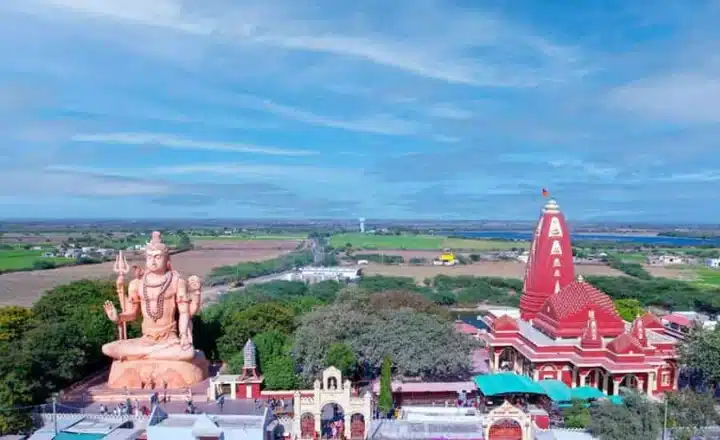
Located near Dwarka in Gujarat, Nageshwar Jyotirlinga is a revered shrine among the 12 Jyotirlingas of India dedicated to Lord Shiva. This temple is distinctive, marked by a colossal statue of Lord Shiva that serves as a symbol of faith, visible even from afar. The temple’s name, Nageshwar, meaning “Lord of Snakes,” commemorates Shiva’s triumph over the demon Daruka. The temple complex, with its peaceful atmosphere and spiritual aura, draws both pilgrims and tourists seeking solace and spiritual insight.
Divine intervention ‐ The tale of Lord Shiva’s victory at Nageshwar
The Shiv Purana narrates the story of a demon named Daruka, who, despite being blessed by Goddess Parvati, Lord Shiva’s consort, misused her boons to terrorize local inhabitants. Daruka imprisoned a devout follower of Shiva, Supriya, along with others. Supriya urged everyone to chant the Shiv Mantra for protection. Enraged by their devotion, Daruka attempted to harm Supriya, but Lord Shiva manifested as a Jyotirlinga to shield her and the other devotees. This miraculous event is why the Jyotirlinga is venerated at Nageshwar Temple today.
Distance from Ahmedabad to Nageshwar: 439.2 km
Temple Timings: The temple welcomes devotees daily from 5:00 AM to 9:00 PM.
Best Time to visit: The best time to visit Nageshwar Jyotirlinga is during the winter season from October to March. During this time, the weather is pleasant, and the temperature ranges between 10°C to 25°C, making it perfect for sightseeing and exploring the temple complex.
9. Eternal flame of divinity ‐ The Kashi Vishwanath Temple in Varanasi
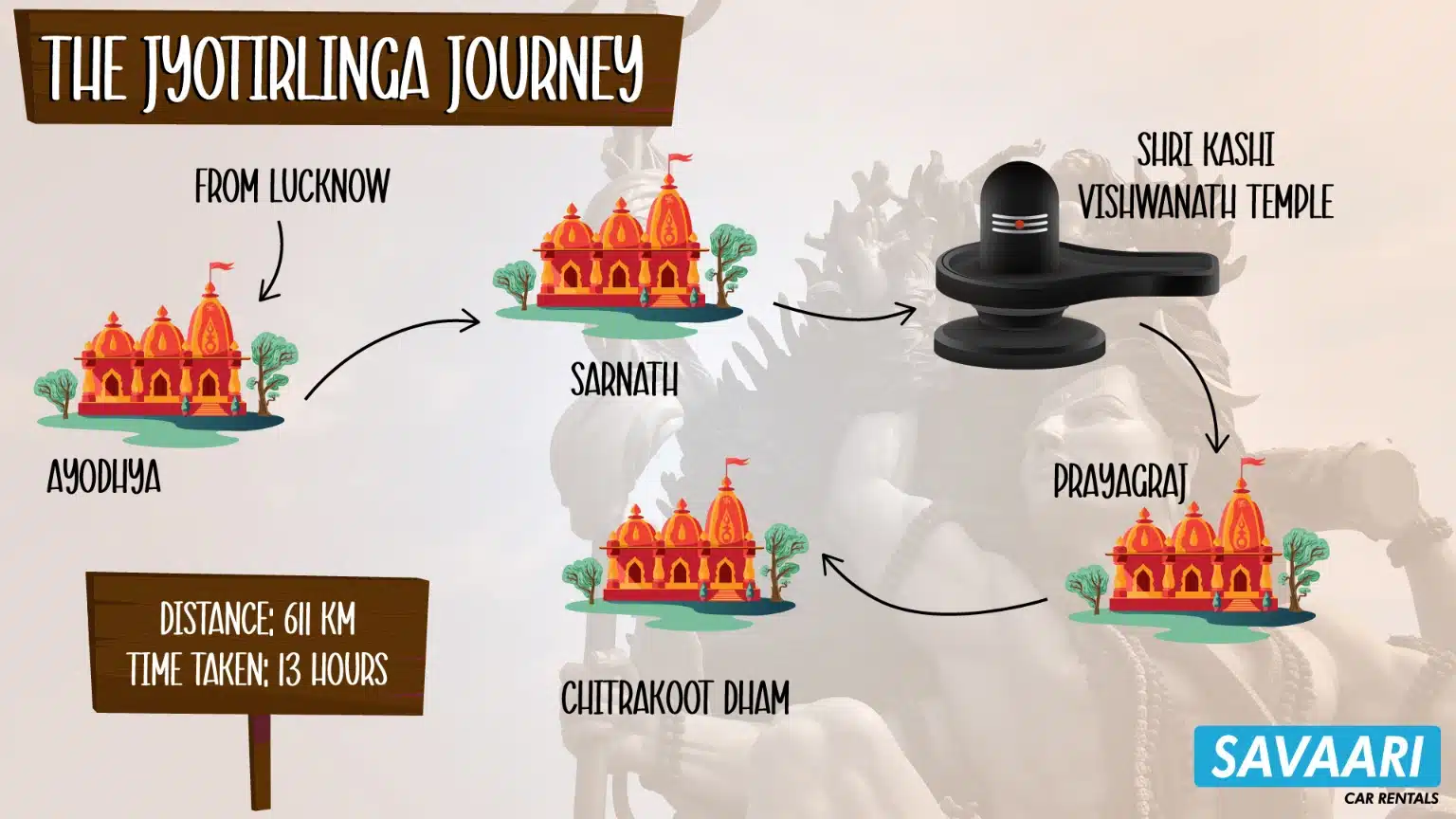
Kashi Vishwanath Temple, nestled in the sacred city of Varanasi, is a pinnacle of spiritual reverence, dedicated to Lord Shiva. Known colloquially as the “Golden Temple” for its splendid gold-plated dome, it captures the devotion of worshippers from across the globe. Situated on the hallowed banks of the River Ganges, the temple embodies more than just religious fervor; it represents the intertwining of life and death in the eternal cycle of existence. Amidst the echoing temple bells, the sanctified aartis, and the enveloping spiritual aura of Varanasi, Kashi Vishwanath stands as a beacon of divinity for pilgrims.
The cosmic pillar ‐ The mythological significance of Vishwanath Jyotirlinga
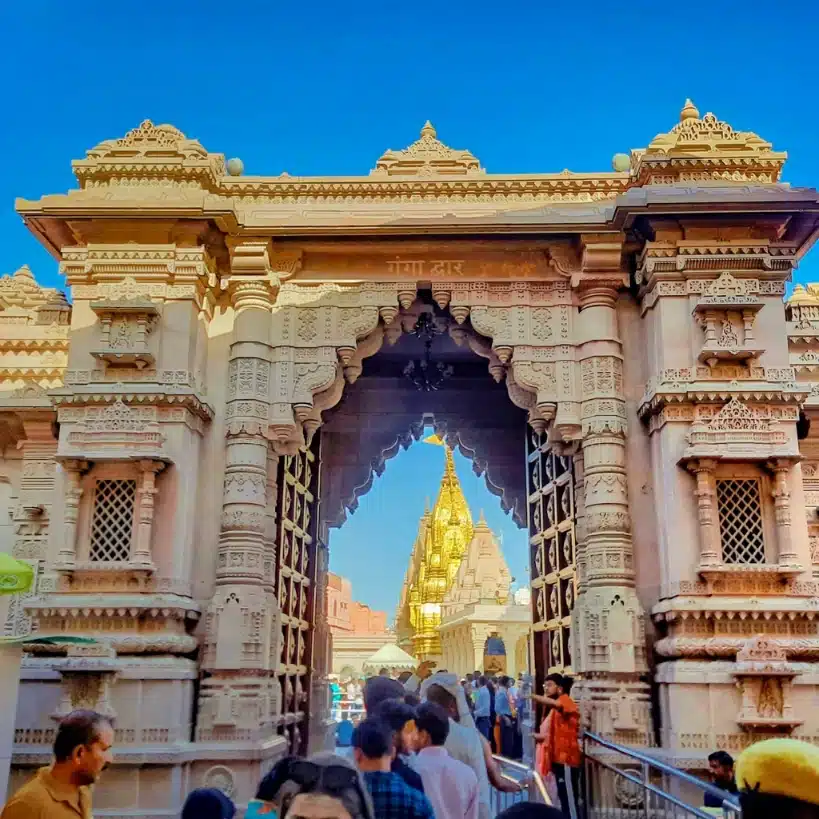
Mythology narrates that Lord Shiva manifested as an infinite pillar of fire to cease the battle of supremacy between Lord Vishnu and Lord Brahma. Both Vishnu and Brahma embarked on quests to find the pillar’s ends. While neither succeeded, Lord Brahma falsely claimed to have found the end. Angered by Brahma’s deceit, Shiva cursed him to be un-worshipped and conferred upon Vishnu the title of supremacy. Though the fiery pillar disappeared, a fragment remained at Kashi, manifesting as the Vishwanath Jyotirlinga.
Distance from Varanasi to Kashi Vishwanath: 6.1 km
Temple Timings: Open daily from 3:00 AM to 11:00 PM
Highlights: The Kashi Vishwanath Temple precinct also includes other holy sites such as the ‘Annapurna Mata Temple’, ‘Visalakshi Temple’, and ‘Kalbhairav Temple’, all of which attract numerous pilgrims.
Best time to visit: Varanasi experiences extreme temperatures, with summers being hot and humid, and winters being cold. The monsoon season, which lasts from July to September, brings heavy rainfall and occasional flooding. Therefore, the best time to visit Vishwanath Jyotirlinga is during the winter months from November to February, when the weather is pleasant and comfortable.
10. The divine splendor of Trimbakeshwar Jyotirlinga in Nasik
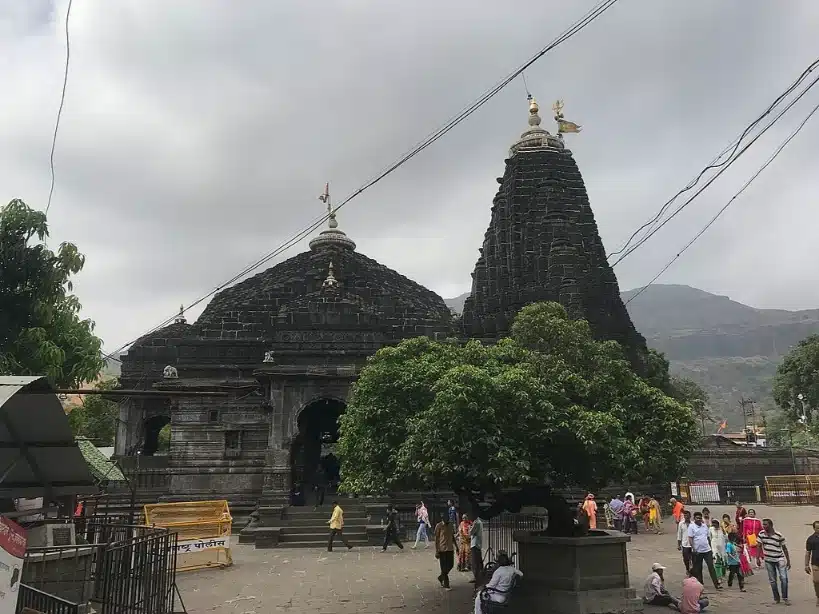
Trimbakeshwar Jyotirlinga, cradled in the serene Brahmagiri mountains in Nasik, Maharashtra, stands as a revered site among the 12 Jyotirlingas of India dedicated to Lord Shiva. This ancient temple, renowned for its unique architectural style, is home to a distinctive linga with three faces, each representing Lord Brahma, Lord Vishnu, and Lord Shiva. Located near the source of the sacred Godavari River, the temple’s setting is imbued with deep spiritual resonance, offering a place of tranquility and contemplation for pilgrims and visitors.
Sage, river, and divinity ‐ The mythical stories of Trimbakeshwar
According to legend, the sage Gautam accidentally caused the death of a cow in his hermitage. Seeking to cleanse his sin, he worshiped Lord Shiva, beseeching him to bring the River Ganga to purify him. The river descended as the Godavari, and upon witnessing this divine intervention, the gods extolled Lord Shiva and implored him to dwell at this location as the Trimbakeshwar Jyotirlinga.
Another tale recounts Lord Shiva residing here in the form of three lingas representing Brahma, Vishnu, and Mahesh (Shiva), giving rise to the temple’s name ‘Trimbakeshwar’. In addition to venerating the Jyotirlinga, pilgrims also partake in a sacred ritual by taking a holy dip at ‘Kushavarta’, the birthplace of the Godavari River.
Distance from Mumbai to Trimbakeshwar: 185.2 km
Temple Timings: The temple is open to devotees from 5:30 AM to 9:00 PM.
Best Time to visit: The best time to visit Trimbakeshwar Jyotirlinga is during the winter months from November to February when the weather is pleasant and the temperatures are comfortable, ranging between 12 to 25 degrees Celsius. This time of year is ideal for exploring the surrounding hills and enjoying the natural beauty of the area.
11. Sacred summit ‐ Kedarnath Jyotirlinga in Uttarakhand
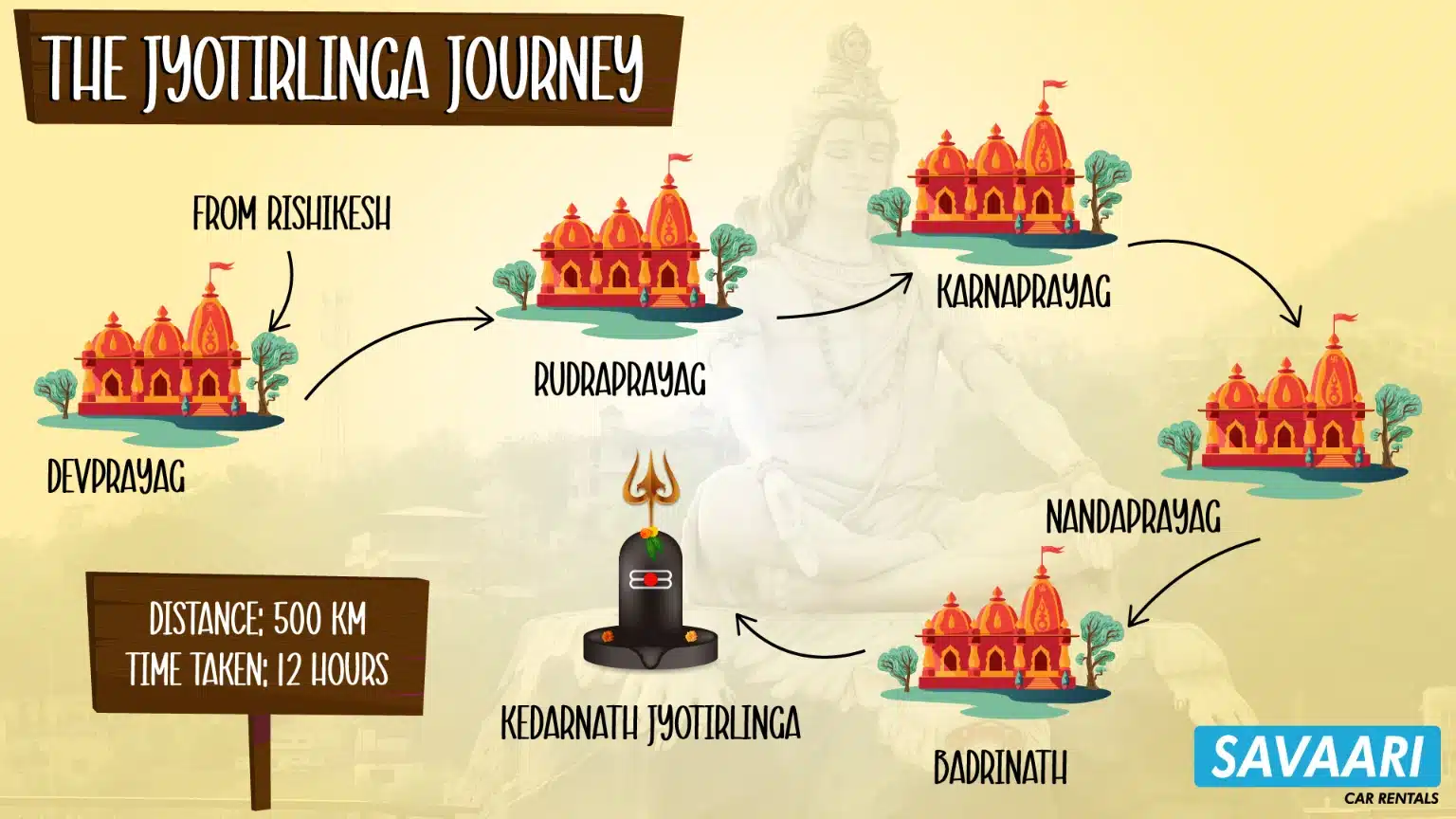
Perched amidst the snowy peaks of the Himalayas in Uttarakhand, Kedarnath Jyotirlinga is revered as one of the most sacred shrines of Lord Shiva. Integral to the Char Dham Yatra and among the elite 12 Jyotirlingas of India, the ancient Kedarnath Temple stands as a beacon of faith and devotion, attracting pilgrims worldwide. With origins traced back to the Pandavas of Mahabharata and later revitalized by Adi Shankaracharya, this temple is not only a spiritual haven but also offers stunning, panoramic views of the Himalayas. The challenging journey to this remote, high-altitude temple elevates Kedarnath to a significant pilgrimage.
Pandavas’ redemption ‐ The mythic genesis of Kedarnath
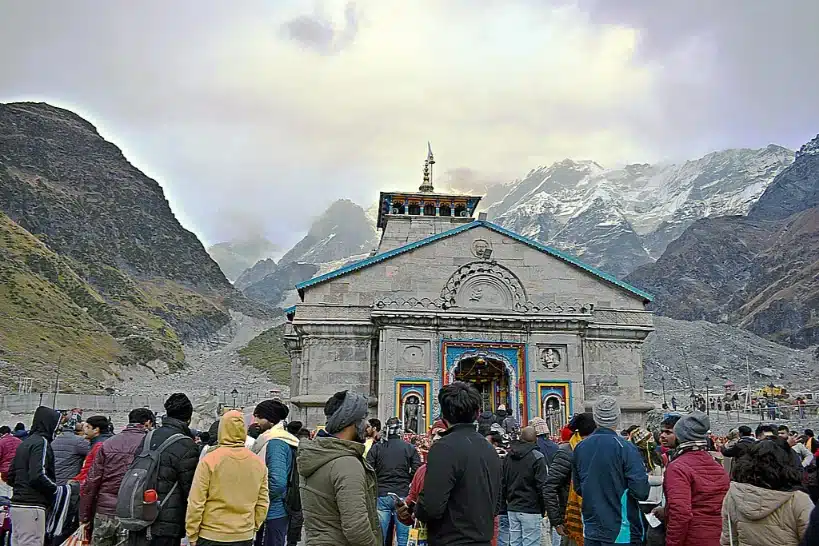
Legend has it that the Pandavas sought atonement for their sins from the Mahabharata battle and performed penance to Lord Shiva here. Impressed by their devotion, Shiva appeared as a triangular Jyotirlinga. Initially built by the Pandavas, the temple was later reconstructed by the Hindu sage, Adi Shankaracharya.
Temple Timings: 4:00 AM to 9:00 PM. However, due to harsh Himalayan weather, the temple is only open from April/May to November annually, with specific dates varying according to the Hindu calendar and weather conditions. Pilgrims are advised to check the temple’s opening schedule for their visit year
Highlights: The mantras for the aarti are chanted in the Kannada language.
Best Time to visit: The best time to visit Kedarnath Jyotirlinga would be from May to June and September to October. During these months, the weather is pleasant, and the temperatures are comfortable, making it an ideal time for sightseeing and outdoor activities.
12. Divine sanctuary of faith ‐ Ghrishneshwar Jyotirlinga in Aurangabad
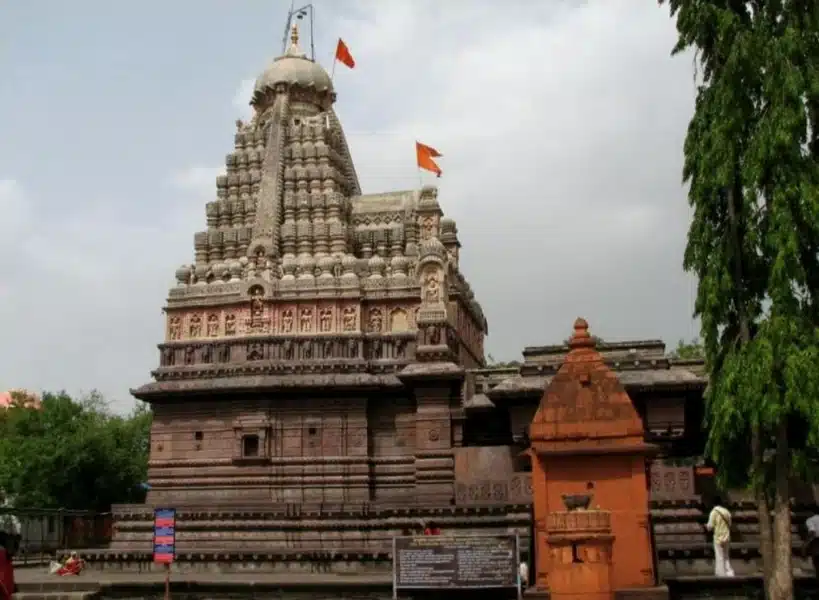
Situated near Aurangabad in Maharashtra, Ghrishneshwar Jyotirlinga marks the last of the 12 Jyotirlingas of India dedicated to Lord Shiva. Adjacent to the UNESCO-listed Ellora Caves, the temple is a magnificent example of medieval Indian architecture, adorned with detailed carvings and sculptures. The temple believed to be built by a devout woman named Kusuma, stands as a testament to unwavering faith. Ghrishneshwar’s serene atmosphere and spiritual essence continue to draw both worshippers and tourists. For a convenient and comfortable trip from Pune airport to Ghrishneshwar, consider booking a Savaari, ensuring a smooth journey to your nearby accommodations.
Ghushma’s faith ‐ The sacred story behind Ghrishneshwar
The Shiv Purana recounts the tale of a woman named Ghushma, whose son was slain by her sister. Overcome with grief, Ghushma devoted herself to Lord Shiva, whose grace restored her son. At Ghushma’s behest, Shiva manifested eternally as the Ghrishneshwar Jyotirlinga at this site.
Distance from Pune to Ghrishneshwar: (256.5 km)
Temple Timings: 5:00 AM to 9:00 PM.
Best Time to visit: The best time to visit Grishneshwar Jyotirlinga is during the winter season, between October to February. During this time, the weather is pleasant and cool, making it ideal for temple visits and sightseeing. The monsoon season, between June to September, can also be a good time to visit Grishneshwar Jyotirlinga as the surroundings turn lush green and the temple complex looks beautiful. However, it is important to note that heavy rainfall can cause landslides and disrupt travel plans.
How to plan the Jyotirlinga road trip ‐ A step-by-step location guide
Embarking on a tour of the 12 Jyotirlingas of India can be a spiritually enriching yet logistically challenging endeavour. To facilitate this divine journey, here’s a comprehensive guide to planning your road trip from various regions of India, ensuring you don’t miss any of these sacred sites.
From Rishikesh
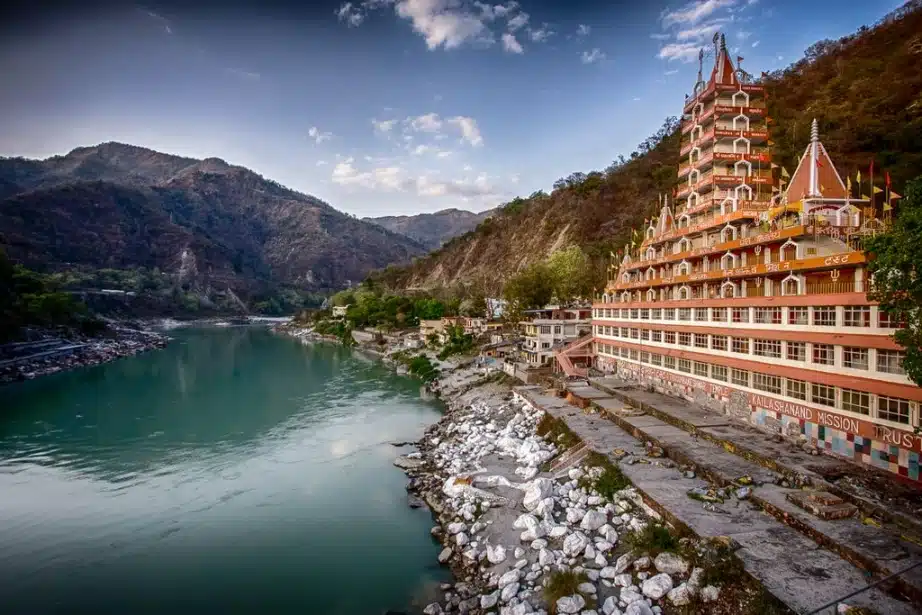
Rishikesh – Devprayag – Rudraprayag – Karnaprayag – Nandaprayag – Badrinath – Kedarnath
Distance: 292 km
Time taken: 9 hr 16 min
Spiritual pitstops along the way
- Rishikesh: A spiritual town with ancient temples and famous for its yoga and meditation retreats. Book a Savaari from Rishikesh to embark on a comfortable road trip to all of these spiritual locations.
- Devprayag: Known for the confluence of rivers Alaknanda and Bhagirathi, forming the Ganges.
- Rudraprayag: Famous for the confluence of rivers Alaknanda and Mandakini.
- Karnaprayag: Renowned for the confluence of rivers Alaknanda and Pindar.
- Nandaprayag: Known for the merging of rivers Alaknanda and Nandakini.
- Badrinath: A sacred town with the famous Badrinath Temple dedicated to Lord Vishnu. Discover everything about the Panch Prayags and their importance by clicking here.
- Kedarnath: Home to the revered Kedarnath Temple, one of the Char Dhams and Jyotirlingas.
From Lucknow
Lucknow – Ayodhya – Sarnath – Shri Kashi Vishwanath Temple – Prayagraj – Chitrakoot Dham
Distance: 13 hr 4 min
Time Taken: 611 km
Spiritual pitstops along the way
- Lucknow: A city with rich cultural heritage and historical monuments.
- Ayodhya: Birthplace of Lord Rama, featuring numerous temples including the Ram Janmabhoomi site. In this comprehensive guide, we will unfold the layers of the Ram Mandir’s story, one that transcends bricks and mortar, and delves deep into the spiritual essence of India’s rich heritage.
- Sarnath: A significant Buddhist site where Lord Buddha delivered his first sermon.
- Shri Kashi Vishwanath Temple: One of the most famous Hindu temples dedicated to Lord Shiva, located in Varanasi.
- Prayagraj: Known for the Triveni Sangam, the confluence of three sacred rivers – Ganga, Yamuna, and Saraswati.
- Chitrakoot Dham: Holds religious importance for its association with Lord Rama and various temples.
From Ranchi
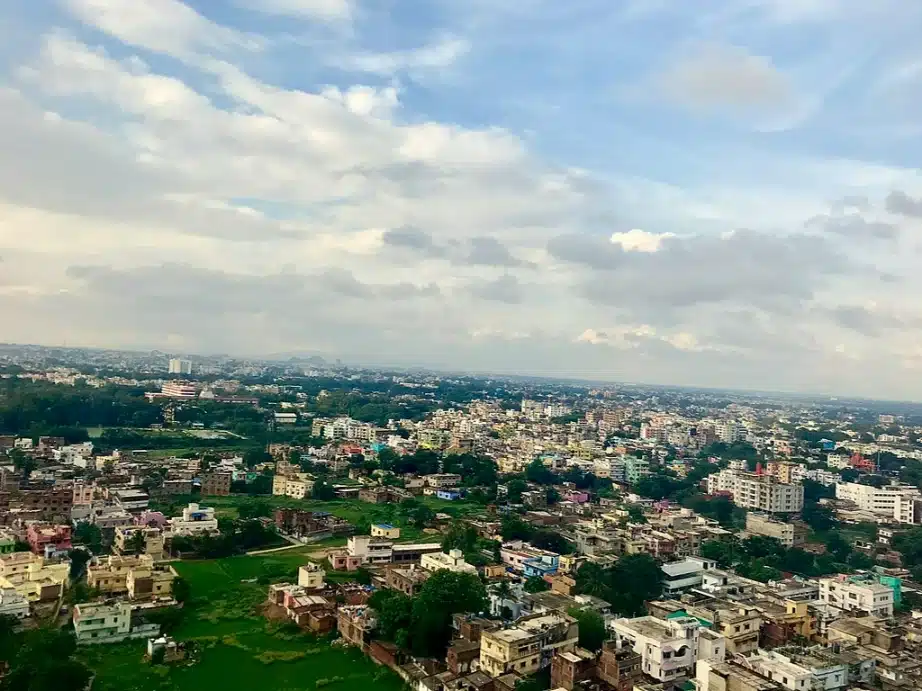
Ranchi – Jagannath Mandir – Shree Baba Baidyanath Jyotirlinga Temple – Satsang Ashram – Basikinath – Malooti temples
Distance: 394 km
Time taken: 9 hr 33 min
Spiritual pitstops along the way
- Ranchi: Capital city of Jharkhand with lush greenery and waterfalls. Book a Savaari from Ranchi to embark on this spiritual road trip.
- Jagannath Mandir: A famous temple in Ranchi, resembling the Puri Jagannath Temple.
- Shree Baba Baidyanath Jyotirlinga Temple: A revered Jyotirlinga shrine in Deoghar.
- Satsang Ashram: A spiritual center established by Thakur Anukulchandra in Deoghar.
- Basikinath: Known for the Basukinath Temple, a significant pilgrimage site.
- Malooti Temples: An ancient complex of temples showcasing architectural heritage.
From Indore
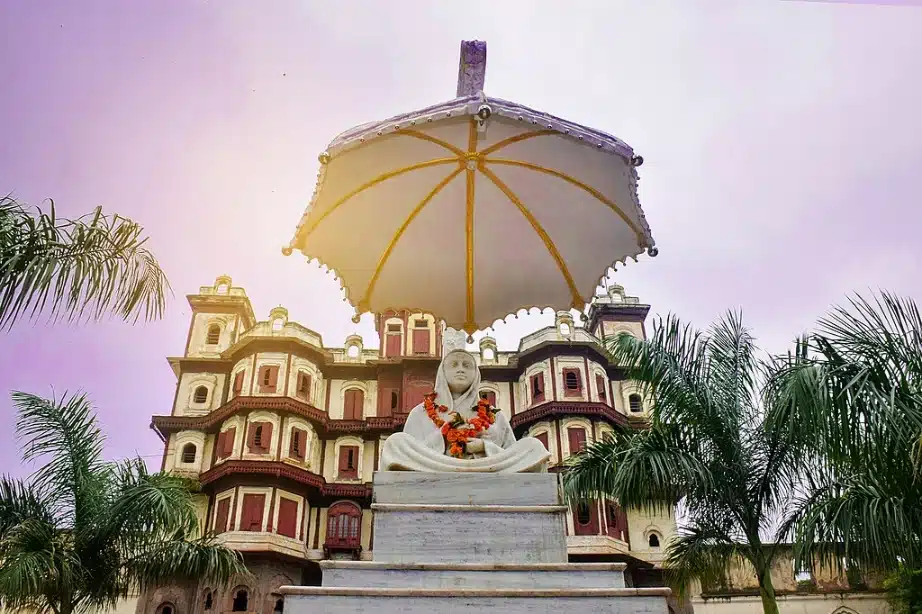
Indore – Omkareshwar Jyotirlinga – Bada Ganpati, Malharganj – Shree Annapurna Temple – Khajrana Ganesh Mandir – Mahakaleshwar Temple – Dwarkadhish Gopal Temple – Bhairav Nath Mandir
Distance: 243 km
Time taken: 7 hr 27 min
Spiritual pitstops along the way
- Bada Ganpati, Malharganj: Famous for housing one of the largest Ganesh statues.
- Shree Annapurna Temple: Dedicated to the goddess of food, Annapurna.
- Khajrana Ganesh Mandir: A popular Ganesh temple built by Ahilyabai Holkar.
- Mahakaleshwar Temple: One of the twelve Jyotirlingas, located in Ujjain.
- Dwarkadhish Gopal Temple: A prominent Krishna temple in Ujjain.
- Bhairav Nath Mandir: Known for the deity Bhairav, a form of Lord Shiva.
From Pune
Pune – Bhimashankar – Grishneshwar – Shirdi – Trimbakeshwar
Distance: 650 km
Time taken: 12 hr 27 min
Spiritual pitstops along the way
- Bhimashankar: A Jyotirlinga shrine set amidst dense forests.
- Grishneshwar: One of the 12 Jyotirlinga shrines located near Ellora caves.
- Shirdi: The famous abode of Saint Sai Baba, a major pilgrimage site. Check out this comprehensive travel guide on Shirdi to make the most out of your trip.
- Trimbakeshwar: A Jyotirlinga temple located near Nashik, associated with the origin of the Godavari river.
From Ahmedabad
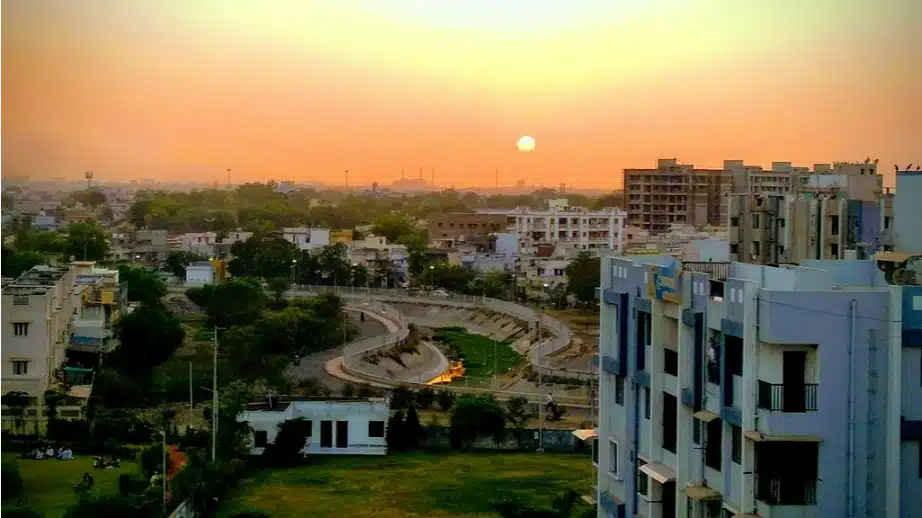
Ahmedabad – ISKCON Rajkot – Shree Somnath Jyotirlinga temple – Shree Dwarkadhish Temple – Shri Nageshwar Jyotirlinga
Distance: 672 km
Time taken: 12 hr 29 min
Spiritual pitstops along the way
- ISKCON Rajkot: A part of the International Society for Krishna Consciousness, known for its spiritual learning.
- Shree Somnath Jyotirlinga temple: One of the twelve Jyotirlingas, famous for its ancient heritage.
- Shree Dwarkadhish Temple: A major pilgrimage site, associated with Lord Krishna’s kingdom. Unveil the mystery of Lord Krishna’s lost kingdom Dwarka by clicking here.
- Shri Nageshwar Jyothirling: One of the 12 Jyotirlingas of India, located near Dwarka.
From Madurai
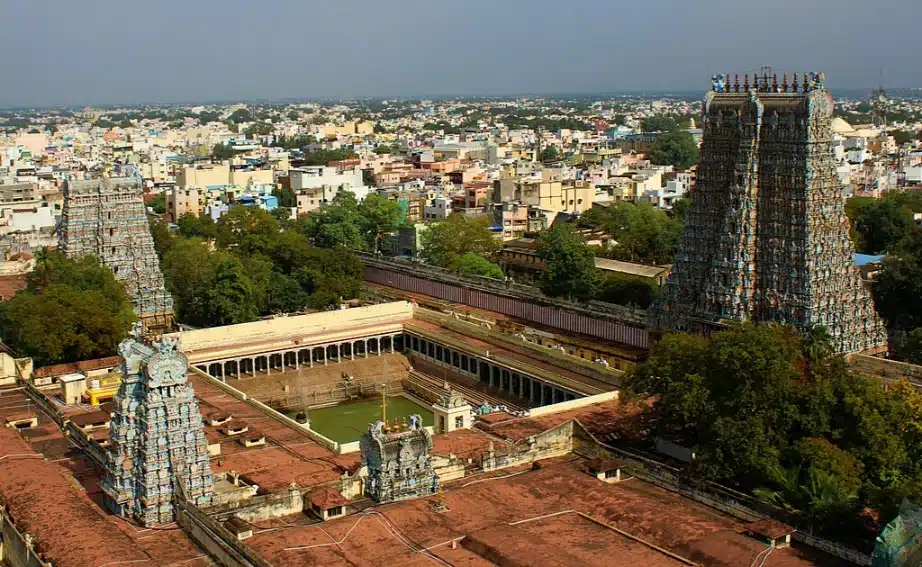
Madurai – Alagar Kovil Temple, Manamadurai – Meenakshi Amman Temple – Sri Sundararaja Perumal Temple, Paramakudi – Shree Rameshwaram Jyotirlinga – Hanuman Temple Dhanushkodi
Distance: 242 km
Time taken: 4 hr 57 min
Spiritual pitstops along the way
- Alagar Kovil Temple, Manamadurai: A historical Vishnu temple with Dravidian architecture.
- Meenakshi Amman Temple: A world-renowned temple dedicated to Goddess Parvati in Madurai.
- Sri Sundararaja Perumal Temple, Paramakudi: A significant Vishnu temple with intricate carvings.
- Shree Rameshwaram Jyotirlinga: A sacred island with one of the twelve Jyotirlingas. Check out this comprehensive travel guide on Rameshwaram to make the most out of your trip.
- Hanuman Temple Dhanushkodi: A notable temple near the ghost town of Dhanushkodi.
From Hyderabad
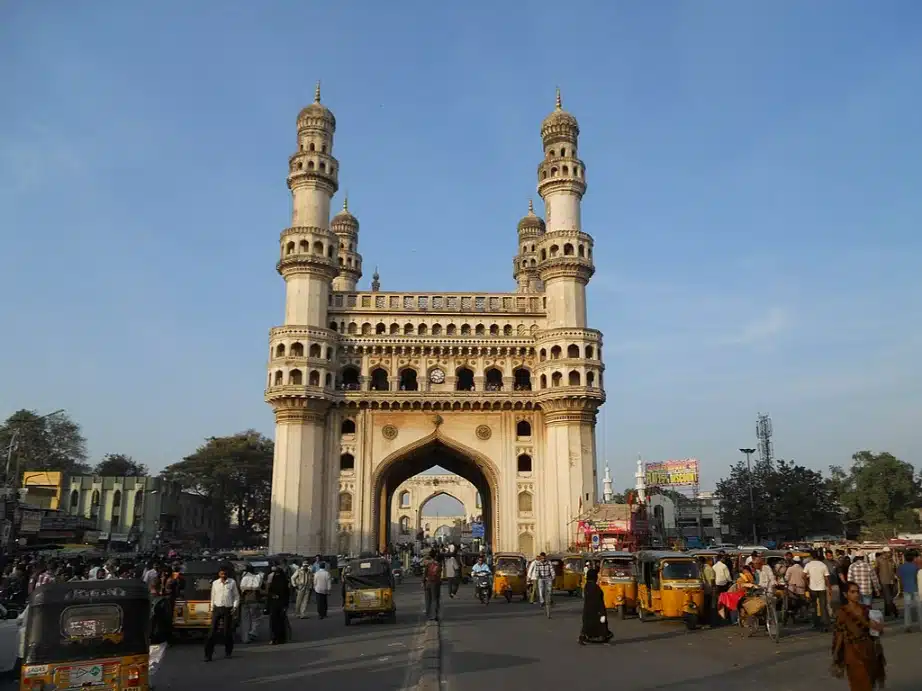
Hyderabad – Chintapally Baba Temple – Anantha Padmanabha Swamy Temple, Khajaguda – Sri Lakshmi Chennakesava Swami Devastanam, Macherla – Mallikarjuna Jyothirlinga
Distance: 368 km
Time taken: 7 hr 56 min
Spiritual pitstops along the way
- Chintapally Baba Temple: A local religious site in the Nalgonda district.
- Anantha Padmanabha Swamy Temple, Khajaguda: Known for its unique rock-cut architecture.
- Sri Lakshmi Chennakesava Swami Devastanam, Macherla: A temple famous for its annual festivals.
- Mallikarjuna Jyothirlinga: Located in Srisailam, it’s one of the twelve Jyotirlingas, revered for Lord Shiva. Check out this comprehensive guide on Srisailam to make the most out of your journey.
Each route is tailored to provide a seamless spiritual experience, allowing devotees to immerse themselves in the divine aura of these revered sites. Remember, the journey to these sacred temples is as significant as the destination itself, filled with cultural insights and profound spiritual growth.
Essential tips for a successful Jyotirlinga road trip
Embarking on a Jyotirlinga road trip is a spiritually enriching journey that requires careful planning and preparation. Here are some tips to ensure a fulfilling and safe pilgrimage:
- Physical and Mental Fitness: Prioritize your health. Regular exercise and a balanced diet will enhance your physical stamina, while practices like meditation can prepare you mentally for the journey.
- Plan Your Route Wisely: Study the locations of the Jyotirlingas and plan your route logically to minimize travel time. Consider the climate and geography of each region to plan accordingly.
- Pack Essentials: Carry necessary items like medicines, first-aid kits, comfortable clothing suited to varying climates, and reusable water bottles. Don’t forget essentials like chargers, power banks, and navigation tools.
- Stay Hydrated and Eat Healthily: Keep hydrated, especially during long drives. Opt for fresh, light meals over heavy, greasy food to avoid discomfort on the road.
- Accommodation Planning: Book your accommodations in advance, especially during peak pilgrimage seasons, to avoid last-minute hassles.
- Respect Local Customs: Each Jyotirlinga has unique customs and rituals. Research and respect these traditions to enrich your spiritual experience.
- Stay Flexible: Be prepared for unexpected changes in plans due to weather, road conditions, or health issues. Flexibility can make your journey less stressful.
Why go on a Jyotirlinga road trip with Savaari?
Embarking on a Jyotirlinga road trip with Savaari offers not just a journey to sacred destinations but also ensures a comfortable and enriching travel experience. With a professional chauffeur at the wheel, you can relax and immerse yourself in the spiritual journey without the stress of navigating through unfamiliar routes. Savaari’s service adds convenience and safety, making your pilgrimage seamless and enjoyable.
Beyond the holy sites, this road trip is an opportunity to explore new destinations, soak in diverse cultures, and create memorable experiences. The flexibility of a chauffeured car allows you to stop at lesser-known attractions, sample local cuisine, and interact with different communities along your path.
By downloading the Savaari app, planning a Jyothirlinga road trip becomes effortless. You can customize your itinerary, choose the vehicle that suits your needs, and get real-time updates for a hassle-free journey. A Jyotirlinga road trip with Savaari isn’t just about reaching the destinations; it’s about the stories you gather, the comfort of the journey, and the spiritual and cultural riches you experience. This is more than a pilgrimage; it’s a journey of discovery, comfort, and divine connection.
Last Updated on January 30, 2024 by Shabari Shankar




